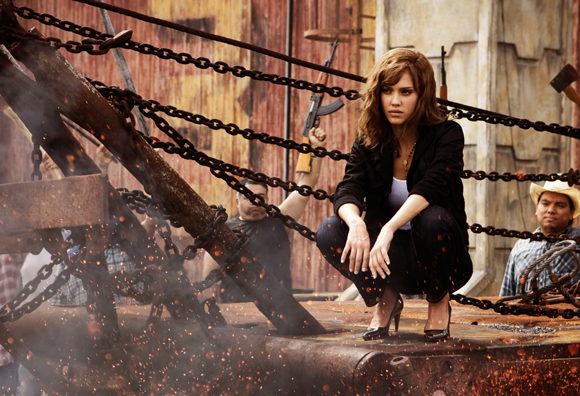She may be playing the ever so conflicted Sartana in Robert Rodriguez’s much-anticipated B-movie exploitation action-adventure Machete, but Jessica Alba didn’t have to think twice when she was offered the part. Despite the fact that the 29-year-old actress, who in the film plays an immigrations officer torn between policing the law and doing what is right, is ”good mates“ with the director, her decision was spurred by something momentous. ”Sartana’s the first Latina character I’ve played,“ she recently revealed in an interview with ’Total Film‘. ”When Robert asked me to play this role – and he told me about this world and how socially relevant this movie was at the same time as being completely entertaining – I was onboard.“
Contrary to her public persona so far as a cute girl who can fill out hot pants and swimwear, it’s a bold role for Alba beyond the daring promise that Machete – Rodriguez’s expansion of the faux trailer from Grindhouse in 2007 – carries some sort of message beneath what is essentially a tongue-in-cheek action romp. What seems more striking here is Alba’s sudden interest in her very own Latin roots. Particularly, since it is not so long ago that the actress who was born to a Danish-French mother and a Mexican-American father, seemed rather uneasy when questioned about her Latino background, allegedly denying its relevance to her persona: ”I never felt connected to one particular race or heritage, nor did I feel accepted by any. If you break it down, I’m less Latina than Cameron Diaz, whose father is Cuban. But people don’t call her Latina because she’s blonde.“ Now that may sound bitchy and hard-nosed, but Alba has been a realist since she got her first break as a teen on the TV show ”Camp Nowhere“ and has worked hard ever since (”I had to hustle since I was twelve“). Besides, there is some truth in her words in that even today Latina stars tread a delicate balance between stereotype and authenticity in their star images, while age-old perceptions continue to contribute to a decided ambivalence inherent in the marketing of Latinas as star figures.
However, as the Hispanic and Latino population in the United States is continually rising, their presence seems to have triggered a jolt through Hollywood over the past decade that demands we sit up and take notice. And Alba is by no means the only female Latin star to set American screens af ame. Jennifer Lopez, Salma Hayek, Eva Mendes, Cameron Diaz, Zoe Saldana or Michelle Rodriguez (who also stars in Machete) have all gained critical recognition and status in the industry in the last few years, creating a growing Latinowood within the traditionally white star system, and eventually making producers and studio executives realize that Latinas no doubt are a box office force to be reckoned with.
Unquestionably striking the blow for the younger generation of Latina screen queens (and paving her own Holly¬wood career) in the late 1990s was Jennifer Lopez, when she rose to on-screen fame as pop star Selena in a biopic of the tragic heroine. Besides being the proud owner of the most coveted rear in the western hemisphere, she quickly became the f rst Latina actress ever to earn a salary in excess of $1million, which not only helped boost her bank account but contributed to change the status of Hispanic or Latina actresses on-screen and off.
Nonetheless, written deep into the souls of many of them is the awareness that things have not always been on the up. That there was a time when it was indeed wise to keep any Hispanic or Latin origin a secret to the extent deemed possible in favour of a movie career. And that it was common practice during the post-studio system era to cast non-Hispanic actresses and actors in Hispanic roles aside the stereotypical dancing pepper pot that Latinas were supposed to conform to, if not being cast as another sort of ”exotic“ gal. Puerto Rican actress Rita Moreno (born Rosita Dolores Alverio), who remarks in her introduction to the book ’Hispanics in Hollywood‘, that at the outset of her career she was doomed to playing ”nameless Indian maidens and Mexican spitf res“, and little changed even after her talent was officially recognized with an Oscar win in 1962 for West Side Story. And looking slightly further back, Moreno certainly wasn’t the only one who had to put up with the forces of institutional racism and stereotyping that has plagued Hollywood, especially during its mogul dominated ’golden‘ period from the 1920s to the 1940s.
Take Mexican actress Dolores Del Rio who from her first film in 1926 became one of the top-20 money earners in Hollywood at her career peak, if only in the few brief years before the transition to sound film. Such superstardom was possible for Del Rio in part because she entered the industry at the right time, when there was a particular interest both in stars with a Latin appearance and in film narratives set in exotic landscapes. In her heyday, she starred in a number of feature films that became critical and box off ce hits and were exported overseas, includ¬ing the silent films What Pride is Glory (1926), Loves of Carmen (1927) and Resurrection (1927). Renowned for her ’ivory‘ skin and ’Spanish ancestry‘, Del Rio portrayed roles of passionate females of a variety of ethnic backgrounds, particularly European, and the studios’ hope was that Del Rio would bridge the gap between these bordering cultures. Yet, in being accepted by Hollywood she ended up turning her back on her Hispanic origins. After the transition to talkies, Del Rio, like other Latino actors, found her opportunities limited by the industry’s desire to foreground ”true“ Americans in sound films. In addition, a shift took place with respect to the promotion of Del Rio as a star body after the transition to sound film. While in the silent era, she was an active subject and protagonist in the films she starred in, her ”Dark Lady“ roles in Latin musicals and other talkies, on the other hand, subtly undercut that dignity by positing her primarily as an ethnic object of the gaze and desire of white men. Even while Del Rio maintained an elegant and classy star image throughout her career, in her 1930s films, she became conf ned to roles as a peripheral Latina or ethnic female who possessed something extra ”south of the equator.“
Likewise, Lupe Velez cashed-in on Hollywood’s one-dimensional mentality which gave only limited opportunities to Mexican actresses at that time. Similar to the era of black buffoonery, Velez rose to fame in several low-budget comedies depicting a hot-tempered Latina in films such as Hot Pepper (1933), Mexican Spitfire (1939) and The Mexican Spitfire Out-West (1940). Such a screen persona provided unneeded fodder to Velez’s real-life embattled marriage to Johnny Weissmuller, star of the early Tarzan movies who was born in the Austro-Hungarian Monarchy. Love indeed knows no colourline, but Velez’s obsession with Weissmuller and later with Austrian actor Harald Maresch fostered a sexually racist message of Latin women needing to be tamed by a white male authority. Velez was reportedly pregnant with Maresch’s child when she killed herself because he refused to marry her.
However, if there was one Latina who was to physically suffer for her art and desire to make it big in the business, it was no one less than Hollywood’s ”Love Goddess“ Rita Hayworth. Of Spanish heritage, Hayworth began making f lms under her real name Rita (short for Margarita) Cansino in the early 1930s after she had been seen dancing by a 20th Century Fox executive who was impressed enough to offer her a contract. Denied her golden ticket to stardom, however, her dreams were crushed at the age of 16 when she found herself replaced by blonde bombshell Loretta Young as the lead in Fox’s remake of the 1928 blockbuster Ramona (played by Dolores Del Rio in the original version). Officially turned down as too young for the part, Cansino’s ethnic name and Latin features had evidently designated her impractical. But things seemed about to change in the early 1940s when Hollywood sought to recapture some of its foreign market by aiming films at Latin American audiences. A rush of Latin-infused movies such as Mexican Hayride, A Weekend in Havana or That Night in Rio hit the movie theatres, starring by then veteran Latina screen queens like Lupe Velez and Dolores del Rio, to whom Cansino was often compared. Yet, it wasn’t until two years later, when Columbia Pictures changed Rita’s last name to Hayworth, prescribed her a painful electrolysis to broaden her forehead and dyed her dark hair to auburn, that she ever stood a chance of being given a great lead role. But she did. Hayworth was sweet and lovable in Cover Girl (1944), but she was also the timeless temptress in Gilda (1946). And although her career began to fade again in the 1950s, by then Hayworth had long proven herself a worthy and capable screen goddess in her own right, who would at some point step back and comment on her personal experience: ”I haven’t had everything from life – I’ve had too much.“
The 1960’s Civil Rights Movement did little to change the one-dimensional image of the Latin women. The multi-ethnic western, Rio Conchos (1964) for example, featured two hot-blooded, impoverished, South-of-the-Border women who gleefully made themselves available to dirty outlaws. Similarly, The Wild Bunch (1969), arguably one of Hollywood’s greatest westerns featured several Mexican women as macho-loving prostitutes. Even gangster classics such as Scarface (1983) and Carlito’s Way (1993) added insult to injury by depicting non-Hispanic actresses as Latinas, which could only be topped by Catherine Zeta-Jones when she was cast as a Mexican in The Mask of Zorro (1998).
Today, of course, things are different. Today, Latino power has become such an issue that this would be akin to asking a white actor to ’black up‘. In fact, films like Machete are made by Latino directors (Rodriguez is on-board here as co-director, co-producer, co-writer and co-editor as well as providing music via his band Chingon), starring Latina actresses in Latina roles, and all together joining forces in their quest to shake things up. And with Hispanic audiences continuously growing, the problem seems to be less one of internal racism, but of ”staying relevant“, as Alba puts it, and fiding an own identity while working in an industry that is happily churning out little ”J-Lo’s“ in order to help box office curves get on a roll.
On a personal level, Machete also adheres to Alba’s new declared manifesto of fearless filmmaking after a lengthy break away from the big screen during which she gave birth to her daughter, Honor, in 2008, decidedly focussing on her private life: ”When I took the time off I decided that if I’m going to do this for a living it has to be good filmmakers, good characters and doing stuff that I’m not always comfortable with.“ And it seems there is a lot of potential here for any director who’s taking the risk to cast Alba in the future beyond her ability of radiating sweet ’n’ cutesy Latina beauty in tame comedies (Good Luck, Chuck, 2007) or guilty pleasure eye-candies (Into The Blue, 2005). Meanwhile, we shall be patient for Machete to hit the big screen, and only as much should be revealed here in that it will be a double challenge for Alba who gets to play identical twins – Latina twins. What more could one want?


